Slovenian Economic Mirror
Related Files:
Slovenian Economic Mirror 4/2022
In the first quarter, growth in the export-oriented sectors of the economy in Slovenia weakened amid heightened uncertainty in the international environment. In the rest of the economy, especially in sectors dependent on domestic demand, activity increased in the first two months and household consumption was also significantly higher. Turnover in trade also continued to rise, partly due to the lifting of the recovered/vaccinated/tested rule in retail trade in non-food products. Turnover in market services increased in current terms in February. Compared to the same period before the epidemic, only travel agencies recorded a significantly lower turnover. In trade in services, only those activities that were strongly affected by the containment measures (travel and personal, cultural and recreational services) are still lagging behind the pre-epidemic period. Amid high demand for labour, unemployment fell to its lowest level in April. Inflation rose sharply again. Apart from energy, all major product and service groups contributed significantly to this increase. The economic sentiment improved slightly in April after a sharp deterioration in March due to the escalation of war in Ukraine. Confidence was higher in most sectors except in manufacturing and among consumers, the main factors here being rising prices and uncertainty about further price increases.
Related Files:
- International environment
- Economic developments
- Labour market
- Prices
- Financial markets
- Balance of payments
- Public finance
The IMF’s April economic outlook
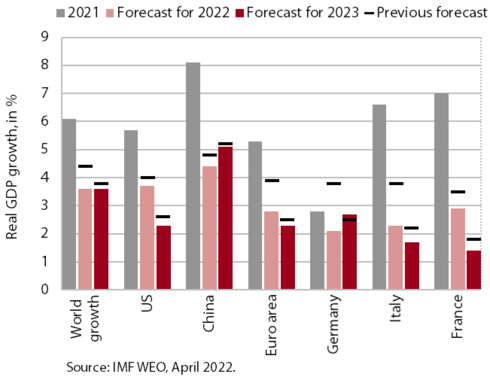
In April, the IMF significantly downgraded its growth forecasts for the global economy. Growth is expected to slow significantly in 2022 (from 6.1% to 3.6%) and stagnate in 2023, mainly due to the Russian military aggression against Ukraine. GDP is expected to fall sharply this year in Ukraine (-35%) and Russia (-8.5%) due to the direct impact of the war and sanctions. Given the impact of the war on commodity prices, trade and financial markets, GDP growth in most other economies will be much weaker than expected at the beginning of the year, especially in the euro area (the January growth forecast was revised down by 1.1 p.p. to 2.8%). Inflation in the euro area will be elevated this year. According to the IMF forecasts, it will reach 5.3% overall in 2022, moderating to 2.3% in 2023 as supply chain pressures ease and commodity prices fall. Global trade growth, which was 10% in 2021, is also forecast to slow markedly, halving in 2022. The forecasts are subject to high uncertainty associated with a number of negative risks, such as the unfolding of the war in Ukraine, suspension of oil and gas supply from Russia to Europe, increased disruptions in global supply chains and inflationary pressures, and rapid changes in monetary policy. The re-emergence of the pandemic also remains a risk.
Quarterly economic growth in Slovenia’s main trading partners
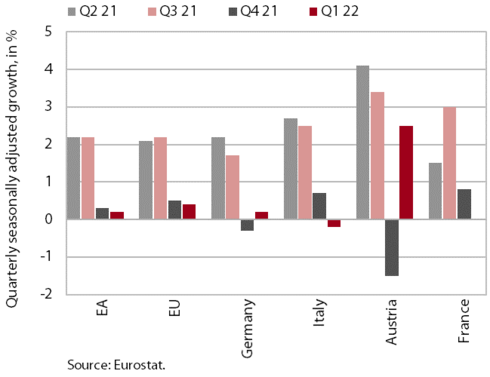
Growth in euro area economic activity continued to slow in the first quarter of this year. According to Eurostat’s flash estimate, GDP growth was 0.2% compared to the last quarter of 2021 (5.0% year-on-year). Among Slovenia’s main trading partners, only Austria recorded solid growth (2.5%); Germany’s GDP grew by a modest 0.2%, France’s stagnated and Italy’s fell by 0.2%. According to confidence indicators (PMI, ESI, Ifo), growth of economic activity in the euro area will remain modest in the second quarter amid rising inflation and significant supply chain disruptions due to the war in Ukraine and the partial closure of the Chinese economy due to COVID-19. Growth among Slovenia’s main trading partners will be significantly lower this year than expected at the beginning of the year. The forecasts were significantly downgraded, especially for Slovenia’s main economic partners, i.e. Germany and Italy. The IMF, which downgraded its January forecast for both countries by more than 1 p.p. in April, forecasts growth of 2.1 and 2.3% respectively for these two countries in 2022.
Commodity prices

After a significant increase in March, prices for energy commodities on international markets fell in April, while prices for non-energy commodities stagnated. Compared to the previous month, the average dollar price of Brent crude oil decreased by 10.5% to USD 104.9 per barrel, though it remained up 61.9% year-on-year. The oil price rose again at the beginning of May amid heightened uncertainty about the future imports from Russia by EU Member States. Natural gas prices on the European market fell by 24% compared to March but were 350.6% higher year-on-year. According to the World Bank, average prices for non-energy commodities on international markets were only slightly higher in April than in March, while they were 28.4% higher year-on-year. After a sharp rise in prices of some non-energy commodities (food, fertilisers and metals) in March, the price increase of most commodities slowed in April, while prices of metals fell. The high year-on-year price increases in all commodity groups, with the exception of wood, continued in April. Inflation, which stood at 7.5% in the euro area in April, continues to be driven mainly by year-on-year increases in energy prices.
Short-term indicators of economic activity in Slovenia
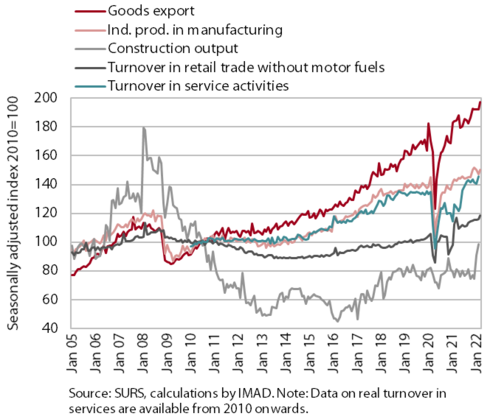
Amid heightened uncertainty in the international environment, growth of activity in the export-oriented part of the economy slowed in the first quarter. According to the available data, trade in goods increased in current terms in the first quarter, albeit at a slower pace than in previous quarters, while activity in manufacturing remained at the previous quarter’s level. This trend was mainly due to the relatively high current growth in March, as activity in the export-oriented part of the economy declined in current terms in the first two months. Growth of activity in sectors more dependent on domestic demand continued in the first two months of the year. In construction, the value of completed works further increased in current terms in February amid a sharp increase in cost pressures. Turnover in trade continued to rise and the lifting of the recovered/vaccinated/tested rule in February contributed to the positive development in the retail trade in non-food products. After two months of decline, turnover in market services also increased in current terms in February. Compared to the same period before the epidemic, only travel agencies recorded a significantly lower turnover. In trade in services, only those activities that were strongly affected by the containment measures (trade in travel and trade in personal, cultural and recreational services) are still lagging behind the pre-epidemic period. After falling sharply in March, the value of the economic sentiment indicator rose slightly in April and was also higher year-on-year. Confidence was higher in most sectors except in manufacturing and among consumers, the main factors here being rising prices and uncertainty about further price increases. Amid ongoing supply chain disruptions and the escalation of the war in Ukraine, the less favourable export expectations have not yet had a noticeable impact on the export-oriented part of the economy.
Electricity consumption
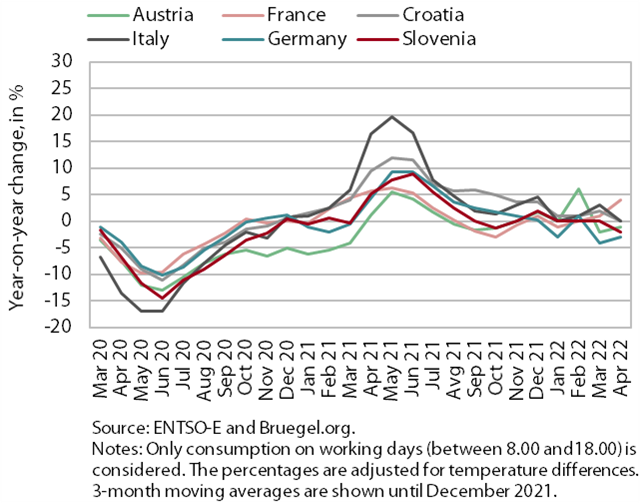
Electricity consumption in April was 2% lower than a year ago and 8% lower than in April 2019. The decrease in consumption is a consequence of lower industrial electricity consumption related to supply chain problems and material shortages, which for some sectors (e.g. the automotive industry) were exacerbated with the outbreak of the war in Ukraine. The lower consumption compared to April 2019 from the perspective of the functioning of the economy could partly be the result of a somewhat less favourable timing of this year’s May Day holidays. Among Slovenia’s main trading partners, consumption in April was higher year-on-year in France (4%), roughly the same in Italy and Croatia, and lower in Austria and Germany (-1% and -3% respectively). Compared to April 2019, consumption was lower in France (-6%), Germany (-5%), Austria (-4%) and Italy (-2%), while it was higher in Croatia (3%).
Electricity consumption by consumption group

In March, industrial electricity consumption was still behind that of the same period before the epidemic, while small business consumption was higher. Industrial electricity consumption remained almost unchanged year-on-year, as did household consumption. Small business electricity consumption was 12.3% higher year-on-year in March, mainly due to last year’s low base. Compared to March 2019, small business consumption was 2.8% higher, as a result of the easing of containment measures in February and of there being two more working days. Nevertheless, industrial consumption was about 1% lower than in March 2019, most likely due to supply problems and a shortage of raw materials. Household consumption was 8.5% higher in March than in the same period of 2019, due to the ongoing COVID-19 infections and the fact that some workers were still working from home.
Road and rail freight transport

In the last quarter of 2021, the volume of road freight transport fell slightly for the second consecutive quarter, while the volume of rail transport increased somewhat. The volume of road transport performed by Slovenian road freight operators decreased quarter-on-quarter, mainly due to a decrease in cross trade transport, while the volume of road transport performed at least partially on Slovenian territory (exports, imports and national transport combined) increased. Compared to the same quarter of 2019, the volume of road transport was 1% higher (transport performed abroad was one-tenth lower, and the other mentioned transport was more than one-tenth higher). Rail freight transport, which was already down before the epidemic, was 3% lower than in the same quarter of 2019. In 2021, the volume of road transport was 4% higher than in 2019, while the volume of rail transport was almost 7% lower.
Traffic of electronically tolled vehicles on Slovenian motorways

In April, freight traffic on Slovenian motorways was 1% higher year-on-year. Current trends are no longer closely linked to the impact of the epidemic, and growth was lower year-on-year, mainly due to there being one less working day. Compared to the same period of 2019, freight traffic volumes were 14% higher in April (adjusted for working days). The share of foreign vehicle traffic, which varies slightly from month to month, was 59% in April, in line with the usual average for that month, whereas in the first year of the epidemic it was significantly lower at 51%. Due to several public holidays, April is one of the months with average traffic volumes, and this April, traffic volumes were also more than a tenth lower than in March.
Turnover based on fiscal verification of invoices, in nominal terms
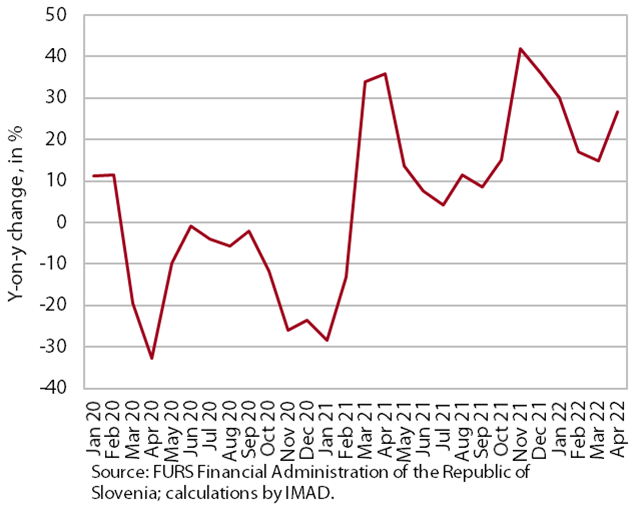
According to data on the fiscal verification of invoices, turnover in April was 27% higher year-on-year in nominal terms and 16% higher than in the same period of 2019, which had two more working days. Year-on-year growth almost doubled compared to March, mainly due to additional COVID-related restrictions in April last year (lockdown between 1 and 11 April and restrictions on movement between regions until 22 April). Year-on-year turnover growth in trade more than doubled compared to March; turnover growth increased significantly in retail trade, and turnover in the sale of motor vehicles, which had declined year-on-year in March, also increased. Year-on-year turnover growth in April was also very high in tourism-related activities, with accommodation and food service activities and certain entertainment activities gradually resuming in the last week of April last year.
Trade in goods – real
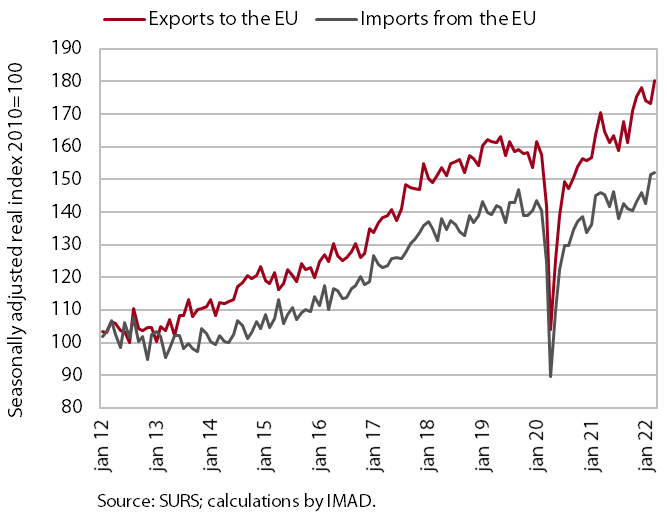
Trade in goods increased in current terms in the first quarter of this year. Real exports of goods increased quarter-on-quarter, as did real exports to EU Member States (seasonally adjusted), but growth was lower than in the previous quarters. The increase was mainly the result of growth in March, as exports had fallen in current terms in the first two months. Quarter-on-quarter, real imports of goods, especially from EU Member States, experienced an even stronger growth than exports (seasonally adjusted). Year-on-year growth in trade with EU Member States remained very high in the first quarter, exceeding pre-epidemic levels since the beginning of last year. Due to the war in Ukraine, export expectations declined sharply in March and April, though they were still higher than before the epidemic.
Trade in services – nominal

After a sharp decline in December 2021, trade in services increased in current terms in the first two months of this year and was again above pre-epidemic levels. The increase in February (seasonally adjusted) was partly due to the recovery of services, especially in transportation and administrative and support service activities. The latter have fluctuated considerably in recent months and had a significant impact on the dynamics of trade in services, especially exports. In February, year-on-year growth in services trade remained very high (30%), due to last year’s low base, and exceeded the level of the same period in 2020 by about 6%. Trade in most services has been above pre-epidemic levels for several months, but the sectors most affected by the containment measures are still lagging behind considerably (trade in travel by 33% and trade in personal, cultural and recreational services by 18%).
Production volume in manufacturing
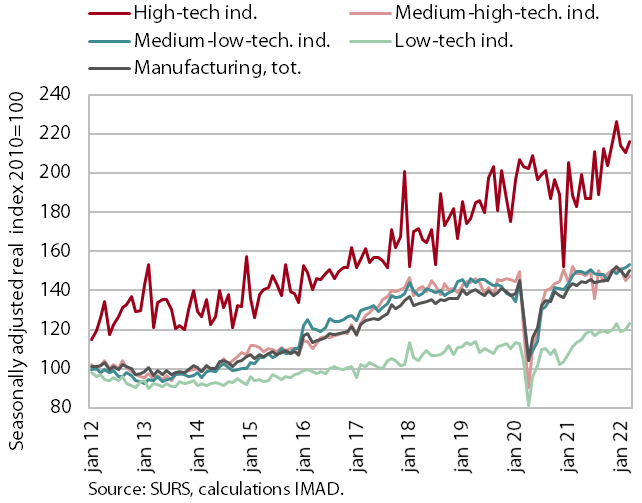
Manufacturing output in the first quarter of this year remained unchanged from the previous quarter. The slowdown in growth was due to lower activity in the first two months of the year. In the first quarter, both high- and medium-high-technology industries recorded a decline, while production volume in medium-low-technology industries increased. On a year-on-year basis, manufacturing output increased in the first quarter but at a slightly lower rate than in the previous quarter. High year-on-year growth was recorded mainly in high- and low-technology industries, while the increase in production volume in medium-high-technology industries was very modest. This is due to the continued unfavourable conditions in the automotive industry, which again suffered a sharp decline in production volume in the first quarter of the year, but also to the problems faced by a major Slovenian car manufacturer.
Activity in construction
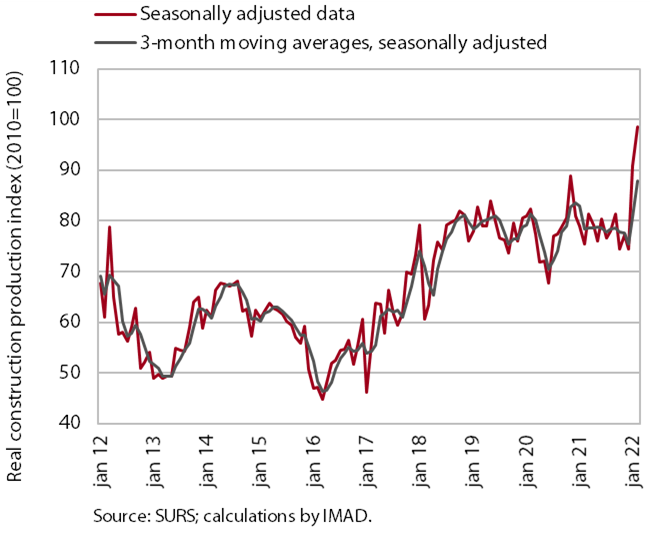
According to figures on the value of construction put in place, construction activity increased in February. After a gradual decline in construction activity last year, the value of construction put in place increased at the beginning of 2022 and was 32.3% higher in February than in February 2021 given the favourable weather conditions. The beginning of the year saw an increase in non-residential construction activity after a long period without growth; this was also the construction segment to have contracted most markedly last year. Activity also rose in the construction of residential buildings and civil-engineering works, while it remained at the level seen at the end of 2021 in specialised construction. Cost pressures are increasing. The implicit deflator of the value of construction put in place (used to measure prices in the construction sector) was above 15% in February, the highest level in the last 20 years. According to business trends in construction, high material costs were cited as a limiting factor by two-thirds of companies in March, while material shortages were cited by 30% of companies, which in both cases is also the highest level in 20 years.
Turnover in trade
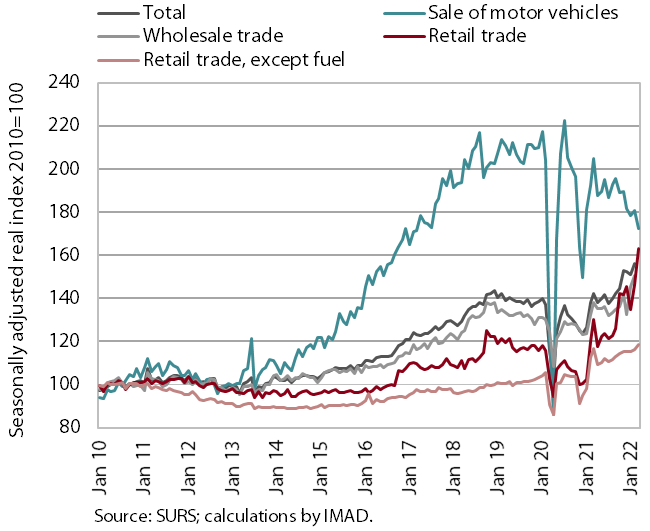
In February, turnover in trade increased in most sectors. The strongest growth was recorded in retail trade, whose dynamics in recent months was determined by strong fluctuations in real turnover from the sale of automotive fuels, which rose sharply in February and continued to increase in March, according to preliminary data. Turnover in this sector thus increased by 77% year-on-year in real terms, which is a much higher increase than the 27% increase observed in the volume of petroleum products sales, which forms the basis for the payment of excise duties. Following the lifting of the recovered/tested/vaccinated rule, trade in non-food products was higher in February and March, while the sale of food, beverages and tobacco products remained at the level of the last quarter of last year. Turnover in wholesale trade continued to increase in February. After declining since October, turnover in the sale of motor vehicles also increased slightly but declined again in March, according to preliminary data, and still falls short of pre-epidemic turnover.
Turnover in market services
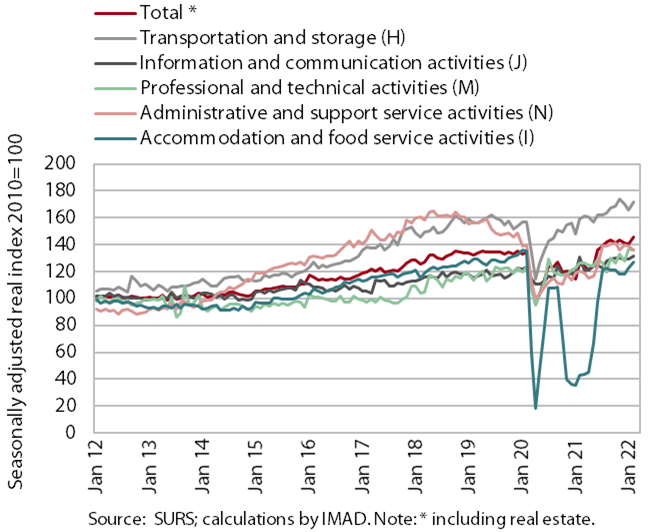
In February, turnover in market services rose again after two months of decline. Compared to the previous month, total real turnover rose by 3.5%, while it increased by 17% year-on-year given the low base in February 2021. The strongest increase in turnover in current terms was in transportation and storage, where it had previously declined for two months, this time mainly due to strong growth in land transport. Turnover continued to grow in accommodation and food service activities and in information and communication activities, where the positive trend in the two main services (computer and telecommunications) continued. After high growth in the previous month, turnover declined slightly in professional and technical activities. Turnover also declined in administrative and support service activities, mainly due to lower turnover in employment services, where it had been increasing since December last year. The lag compared to turnover before the epidemic (February 2020) was only noticeable in travel agencies (by 48%).
Selected indicators of household consumption

Household consumption was significantly higher year-on-year in the first quarter. This was due to last year’s low base as a result of restrictions on business activity and on the movement of individuals and higher sales this year related to the lifting of the recovered/vaccinated/tested rule in February and expected further price increases (e.g. of automotive fuels) due to the escalation of the war in Ukraine. Compared to the last quarter of 2021, domestic consumption increased mainly in accommodation and food service activities, while consumption for non-food products was also slightly higher. The already low sales of passenger cars to households further decreased, which was also affected by the extended delivery times due to supply chain disruptions.
Economic sentiment
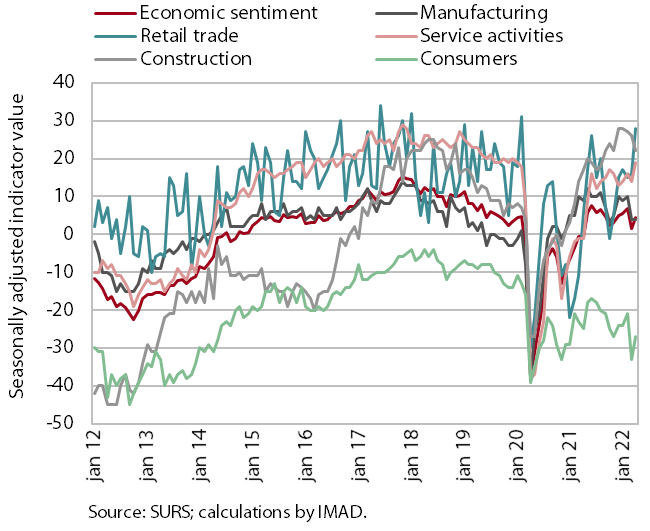
After falling sharply in March, the value of the sentiment indicator rose again slightly in April and was also higher year-on-year. Confidence was significantly higher year-on-year in retail trade (by 22 p.p.) and in service activities (by 20 p.p.) and slightly higher in construction (by 5 p.p.). Year-on-year, confidence was slightly lower among consumers and in manufacturing (by 2 and 5 p.p. respectively). Confidence among consumers is most affected by rising prices and uncertainty about further price increases, which in turn affects expectations about the future financial situation of households, while confidence in manufacturing is strongly influenced by the situation in the international environment, most recently by the bottlenecks in the supply of raw materials, rising commodity and energy prices, and the Russian–Ukrainian war.
Number of employed persons

In February, the year-on-year growth in the number of persons in employment remained high (3.2%). It was the strongest in accommodation and food service activities and in construction. In the latter, the number of persons in employment was significantly higher than before the epidemic, while in the former it remained slightly below the level of two years ago. Amid economic recovery, growth in the number of persons in employment still depended largely on the employment of foreign workers, whose contribution to overall year-on-year growth was more than 50% in February. The share of foreigners among all persons in employment is also increasing, up 1.2 p.p. to 12.8% last year. This is largely related to the shortage of domestic labour, which is most pronounced in construction and administrative and support service activities (mainly due to a high job vacancy rate). The activities with the largest share of foreigners are construction (45%), transportation and storage (31%), and administrative and support service activities (24%).
Number of registered unemployed persons
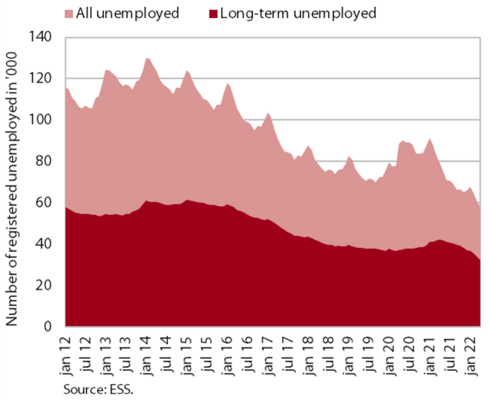
Against the backdrop of the lowest unemployment rate to date, the decline in the number of registered unemployed in April was similar to the previous month (-2.1%), according to the seasonally adjusted data. According to original data, 58,081 people were unemployed at the end of April, 4.1% fewer than at the end of March and 26.7% fewer than a year earlier. Under conditions of high demand for labour, which is also reflected in the high vacancy rate, the number of long-term unemployed has also been declining since May last year – in April, their number was 23.6% lower than in April 2021. Of the long-term unemployed, more than two-thirds have been unemployed for more than two years.
Average gross wage per employee
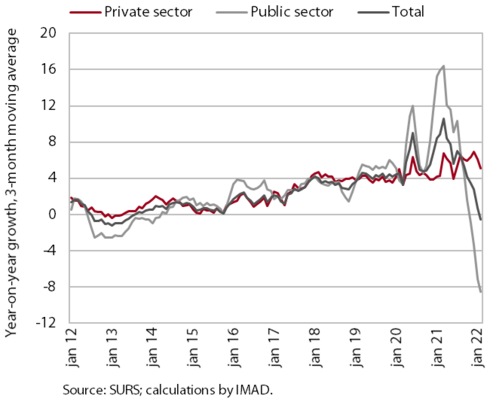
In February, average wages in the public sector were 8.4% lower year-on-year, while they were 4.2% higher in the private sector (-1.0% overall). Due to the cessation of epidemic-related allowances, year-on-year wage growth in the public sector slowed significantly in the second half of last year and turned negative year-on-year last November. Year-on-year growth in the private sector in February was similar to the previous month and lower than in the last few months of 2021, partly due to a relatively high base last year (given a large increase in the minimum wage and the impact of the methodology used to calculate average wages). Growth was the highest in accommodation and food service activities and was also high in construction and transportation and storage, which could already be the consequence of labour shortages.
Consumer prices
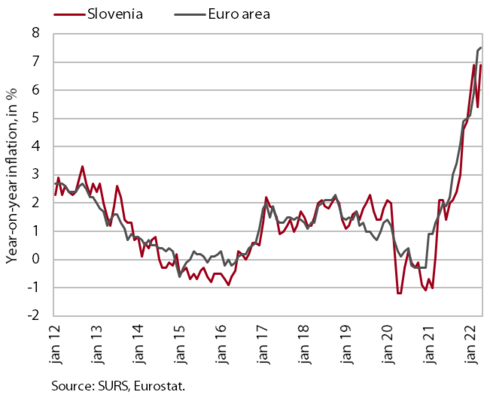
Inflation rose sharply again in April to 6.9% year-on-year. The increase was largely due to energy prices, currently especially petroleum product prices, which rose by more than 30% year-on-year despite the current administered prices. Due to the temporary exemption from paying certain contributions, electricity prices fell by more than a fifth year-on-year. Compared to March, the year-on-year decline slowed considerably due to the high monthly increase (11.6%), as suppliers continued to pass on higher prices on wholesale markets to final customers. Amid high energy and input prices and geopolitical uncertainties, prices for food and non-alcoholic beverages continued to rise and were almost a tenth higher year-on-year. The largest price increases were for oils and fats, which were a fifth higher, and the price increase for bread and cereal products was also above the average (13%). The year-on-year increase in durable goods prices in April was similar to previous months (8.8%). Growth in service prices, which hovered around 3% earlier this year, rose to 5% in April. This was mainly due to higher prices in recreation and culture, where prices of package holidays rose by about 8% in the face of high demand and were almost a fifth higher month-on-month. Prices also continued to rise in the restaurants and hotels group and in services related to housing.
Slovenian industrial producer prices

Growth of Slovenian industrial producer prices increased in March, reaching 17.9% year-on-year. Prices increased year-on-year in all industrial groups. Growth was slightly stronger in the domestic market, where prices were about one-fifth higher on average. Overall price growth continues to be driven mainly by intermediate goods, whose prices were 23.8% higher year-on-year. The strongest year-on-year increase was still recorded by energy prices, which rose by almost 55%, but their contribution to overall growth was less due to their lower weight compared to intermediate goods. Capital goods prices increased by about 10% year-on-year in the first quarter of this year. Consumer goods prices continued to rise gradually, increasing by 7.1% year-on-year in March. Prices for the group of non-durable goods grew somewhat more strongly, by 7.4%, while prices for durable consumer goods rose by 6% year-on-year.
Growth in loans to domestic non-banking sectors
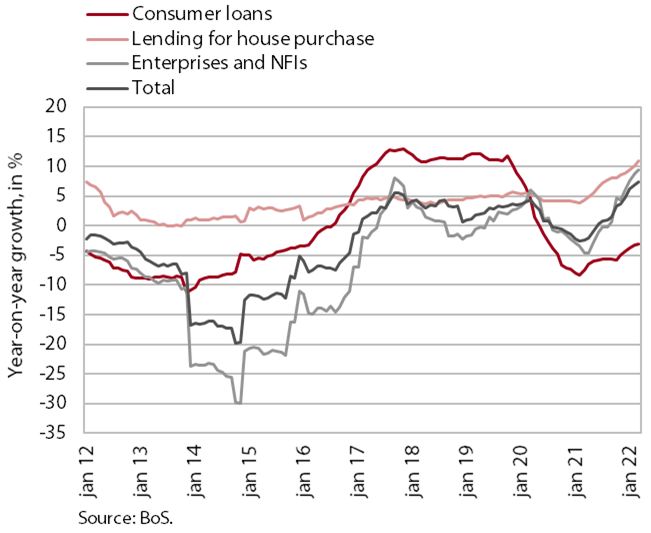
Year-on-year growth in the volume of bank loans to domestic non-banking sectors continues to increase gradually, reaching 7.4% in March, the highest level since June 2009. Growth in corporate and NFI loans and loans to households has also increased. According to our estimate, this is partly a consequence of expected higher interest rates. The volume of corporate and NFI loans has increased by almost a tenth year-on-year. The volume of NFI loans is growing much faster, by a quarter year-on-year, while the growth of corporate loans remains at around 8%. Growth in loans to households (6.8%) is also gradually increasing, mainly due to a one-tenth increase in the volume of housing loans. With the modest current growth, the year-on-year decline in consumer loans slowed further. Year-on-year growth in domestic non-banking sector deposits (4.6%) has slowed rapidly, almost halving compared to the end of last year. Growth in both household and corporate deposits has slowed. The quality of banks’ assets remains solid, and the share of non-performing loans was 1.2% in February.
Current account

The surplus of the current account of the balance of payments has declined. The 12-month current account surplus was down year-on-year, amounting to EUR 1.1 billion (2.0% of estimated GDP). The year-on-year decline in the surplus in current transactions arose mainly from the trade balance, which turned from a surplus to a deficit. This is related to rising prices for energy and other primary commodities, since import prices have been rising much faster than export prices in recent months. The primary income deficit was also higher, largely due to higher dividend payments and profits by foreign investors. The surplus in trade in services continued to increase, especially in trade in travel and other business services. The deficit in secondary income was lower, mainly due to year-on-year lower VAT- and GNI-based contributions to the EU budget.
Consolidated general government budgetary accounts

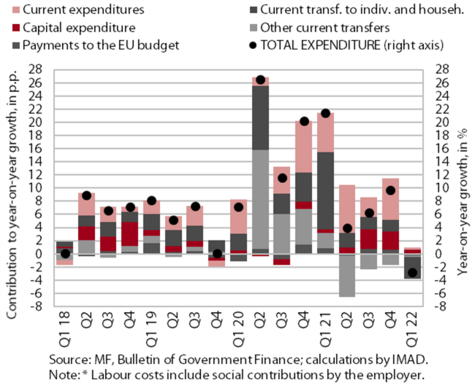
The deficit of the consolidated balance of public finances was significantly lower in the first quarter of 2022 than in the same period of 2021. It totalled EUR 317.6 million in the first quarter of 2022, compared with EUR 1.3 billion in the same period last year. This reflects the high growth in revenue (16.8%) and lower expenditure (-2.8%). The increase in revenue growth was the result of continued growth in economic activity and favourable labour market conditions. It arose mainly from higher revenues from value added tax and corporate income tax. Receipts from the EU budget also increased significantly due to the inflow of funds from the Recovery and Resilience Facility and from structural funds under the 2014–2021 multiannual financial framework (MFF). The decrease in revenue in the first quarter was related to lower expenditure on measures to mitigate the impact of the epidemic, which amounted to EUR 331.7 million, compared to EUR 949 million in the first quarter of 2021. Expenditure was thus lower mainly on civil servants’ wages, transfers to individuals and households, and subsidies. On the other hand, expenditure on goods and services and investments increased.
Projections of the Stability Programme 2022

The projections of the Stability Programme 2022 foresee a deficit of 4.1% of GDP for the general government sector (5.2% of GDP last year). Assuming no change in economic policy, the deficit and debt are expected to further decrease gradually in the coming years. The deficit is projected to fall to 1.7% of GDP and the debt to 68% of GDP by 2025. Projections for the general government deficit without taking into account COVID-19 measures show that the deficit will be higher in 2022 and 2023 than in 2020 and 2021, mainly due to certain structural measures (tax cuts and statutory increases in expenditure for various purposes) and high planned investment. For the entire projection period, the Stability Programme foresees further revenue growth, thought this is expected to be lower than last year (11.9%), due to the expected slowdown in economic growth and tax relief (personal income tax and excise duties). It is expected to be highest in 2022 (6.1%) and average 4.4% over the period 2023–2025. The projected expenditure growth is also lower than in 2021 (6.1%) throughout the projection period, despite the expected strong increase in the level of investment in 2022 (by 47%) and a further increase in 2023, when it is expected to peak at EUR 3.9 billion (6.6% of GDP). In 2022, lower spending on measures to mitigate the consequences of the epidemic, estimated at EUR 450 million in 2022 and amounting to EUR 2.4 billion in 2021, will contribute to lower expenditure growth (3.8%), despite higher investments and aid measures to mitigate the consequences of rising energy prices and aid related to the war in Ukraine. In the medium term (2023–2025), given the expected decline in investment in 2024 and 2025 and the no-policy-change scenario, annual expenditure growth is projected to be relatively low, at 2.6%.
Receipts from the EU budget
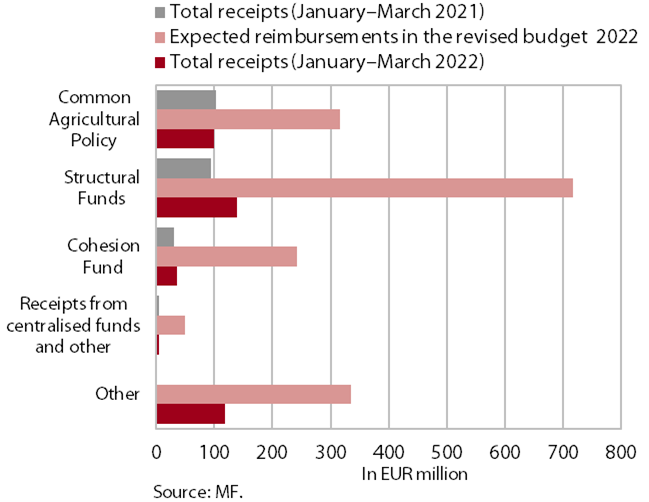
Slovenia’s net budgetary position against the EU budget was positive in the first quarter of this year (at EUR 215.5 million). In this period, Slovenia’s receipts from the EU budget amounted to EUR 397.7 million (24.0% of receipts envisaged), while its payments to the EU budget amounted to EUR 182.2 million (32.3% of planned payments). The bulk of receipts (34.9% of all receipts) were funds from the structural funds, and just under a third (29.8%) were funds from the Recovery and Resilience Facility. 25% of all funds received under the Common Agricultural and Fisheries Policy were reimbursed to the budget of the Republic of Slovenia, while funds from the EU Cohesion Fund accounted for the smallest share (9%).
